
The official canonization portrait of Mother Teresa by American artist Chas Fagan
On Sunday, September 4, 2016, during a Mass celebrated in front of over 120,000 faithful in St. Peter’s in Rome, Pope Francis canonized Mother Teresa of Calcutta, universally known in the world as founder of the Missionary Sisters of Charity, who care for the poorest and most neglected in society. Already considered a saint in her lifetime, she was beatified by John Paul II on October 19, 2003.
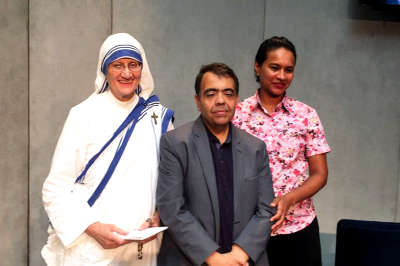 From left to right: Sister Mary Prema Pierick, the Superior General of Mother Teresa’s Missionaries of Charity Order; Marcilio Haddad Andrino, who was declared miraculously healed through Mother Teresa’s intercession; his wife Fernanda Rocha Nascimento. From left to right: Sister Mary Prema Pierick, the Superior General of Mother Teresa’s Missionaries of Charity Order; Marcilio Haddad Andrino, who was declared miraculously healed through Mother Teresa’s intercession; his wife Fernanda Rocha Nascimento. |
Another miracle, obtained after the beatification, was required for the next step, that is to say, canonization. The beneficiary of this miracle, Marcílio Haddad Andrino, who was miraculously healed through the intercession of Blessed Teresa in 2008, gave a testimony of his healing during a press conference at the Vatican, on September 2, 2016. The Brazilian man, who suffered from severe brain infection, found himself miraculously healed after having obtained a relic of Mother Teresa.
After his miraculous recovery, the doctors told Marcílio and his wife Fernanda Rocha Nascimento that following these health problems, the couple had statistically less than 1% chance of conceiving. Within a year, his wife became pregnant and they were able to have two children, even though Andrino had been told that the powerful drugs he had taken had made him infertile. He called his two children “the extension of that miracle.”
During the same press conference, Father Brian Kolodiejchuk, postulator of the cause of canonization, said that Mother Teresa is the perfect saint for the Year of Mercy” adding that “Mother Teresa is a saint for everyone, for the poor and the rich, and for our time, devastated by so much violence and aridity of heart.”
Before introducing her biography, here are a few notes about the first years of Gonxha Bojaxhiu, the young Albanese who would become Saint Teresa of Calcutta:
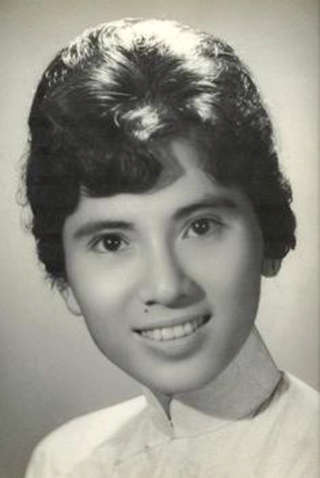 Gonxha at age 18 Gonxha at age 18 |
The sudden death of her father Nikola, when Gonxha was about eight years old, left the family in financial straits. Her mother Drane raised her children firmly and lovingly, greatly influencing her daughter’s character and vocation. Gonxha’s religious formation was further assisted by the vibrant Jesuit parish of the Sacred Heart in which she was much involved. At the age of eighteen, moved by a desire to become a missionary, Gonxha left her home in September, 1928, to join the Sisters of Loreto, in Ireland. In December, she departed for India, arriving in Calcutta on January 6, 1929.
On September 10, 1946 during the train ride from Calcutta to Darjeeling for her annual retreat, Mother Teresa received her “inspiration,” her “call within a call.” On that day, in a way she would never explain, Jesus’ thirst for love and for souls took hold of her heart, and the desire to satiate His thirst became the driving force of her life. Over the course of the next weeks and months, by means of interior locutions and visions, Jesus revealed to her the desire of His heart for “victims of love” who would “radiate His love on souls.” “Come be My light,” He begged her. “I cannot go alone.” He revealed His pain at the neglect of the poor, His sorrow at their ignorance of Him, and His longing for their love. He asked Mother Teresa to establish a religious community, Missionaries of Charity, dedicated to the service of the poorest of the poor. Nearly two years of testing and discernment passed before Mother Teresa received permission to begin. On August 17, 1948, she dressed for the first time in a white, blue-bordered sari and passed through the gates of her beloved Loreto convent to enter the world of the poor.
Here is now a biography of the new saint, taken from the September, 1998 monthly spiritual newsletter of Saint Joseph de Clairval Abbey:
 |
“By blood, I am Albanian. By citizenship, an Indian. By faith, I am a Catholic nun. As to my calling, I belong to the world. As to my heart, I belong entirely to the Heart of Jesus.” – Saint Teresa |
by Dom Antoine-Marie, OSB
December 1964. Pope Paul VI is in Bombay to preside at the International Eucharistic Congress. Several million people are crowded all along the twenty kilometer route between the airport and the city. All wish to see and hear “the world’s greatest religious leader.” Mother Teresa of Calcutta is among those invited to the Congress. But on the way to the palace, she has come across a man and his wife, exhausted, with bloody faces, so thin that there is but skin over their bones. Mother Teresa approaches, tries to help. The man has just the time to pronounce a few words before expiring. Without hesitation, Mother Teresa loads the woman over her shoulders and carries her to the Home for the Dying. This exhausted woman represents Jesus and she must be assisted before all else, even if it means missing such a precious encounter with the Vicar of Christ. As long as you did it to one of these my least brethren, you did it to Me, Jesus will say at the Last Judgment (Mt 25: 40).
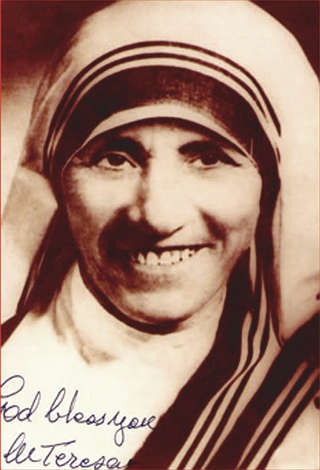 Mother Teresa in 1948 Mother Teresa in 1948 |
Gonxha (Agnes) Bojaxhiu, the future Mother Teresa, was born on August 26, 1910 in Skopje (ex-Yugoslavia). Her family, of Albanian nationality, was deeply Catholic. Around 1928, a special grace received from the Most Blessed Virgin, led Gonxha to the religious life. She was received by the Sisters of Our Lady of Loretto in Dublin, Ireland, whose Rule takes inspiration from the spirituality of the Spiritual Exercises of Saint Ignatius of Loyola. Gonxha meditated on the meaning of life: “Man is created to praise, reverence and serve God Our Lord, and by this means to save his soul” (Spiritual Exercises, 23). She wanted “to help all men” (ibid. 146) to find the way to Heaven.
Gonxha felt drawn by the missions. Her Superiors sent her to Darjeeling, India, city situated at the foot of the Himalayas, and there she began her novitiate on May 24, 1929. The main vocation of the Sisters of Loretto is teaching. Gonxha taught class for little girls, all the while continuing her own studies in order to obtain a teaching diploma. On May 25, 1931, she pronounced her religious vows and took the name of Sister Teresa, in honor of Saint Thérèse of Lisieux. To complete her studies, Sister Teresa was sent, in 1935, to Calcutta College in the midst of the overpopulated and unhealthy capital of Bengal. There she found herself side by side with misery: an entire population living and dying, being born on the sidewalks, having for roof nothing but a bench, the edge of a door, an abandoned cart, some newspapers or cardboard... Infants die at birth and are thrown into the garbage or in the gutter, just anywhere. Each morning, the dead are collected together with piles of trash
On September 10, 1946, while praying, Sister Teresa distinctly perceived Our Lord inviting her to leave the Loretto convent to dedicate herself to serving the poor, by living in their midst. She opened her soul to her superior who made her wait in order to test her obedience. After a year, the Holy See authorized her to live outside the cloister. On August 16, 1947, at age thirty-seven, Sister Teresa put on for the first time a white sari made of coarse cotton fabric (traditional dress worn by Indian women), adorned with a blue stripe in honor of the Most Blessed Virgin Mary. At the shoulder, she wore a small black crucifix. For her travels, she had a small bag containing indispensable personal effects, but no money. Mother Teresa never asked for money; she never had any in her possession. Nevertheless, her works and foundations demanded very heavy expenses. Divine Providence always provided.
Beginning in 1949, young girls, ever more and more numerous, came to share Mother Teresa’s life. She tried them for a long time before granting admittance. In the fall of 1950, Pope Pius XII officially authorized the new foundation, called “Congregation of the Missionaries of Charity.”
 Postage stamp issued by the Vatican on the occasion of the canonization of Mother Teresa Postage stamp issued by the Vatican on the occasion of the canonization of Mother Teresa |
One day during the winter of 1952, she went looking for the poor, and found a woman agonizing in the street, too weak to defend herself from the rats which were gnawing at her toes. She carried her to the closest hospital, where after many difficulties, the dying woman was finally accepted. Mother Teresa then had the idea of asking the city for a place to receive abandoned dying persons. A house which used to serve as residence for pilgrims at the Hindu temple of “Kali the Black,” and now used by all kinds of vagabonds and peddlers, was put at her disposal. Mother Teresa accepted. Many years later, she would say, concerning the thousands of persons who died in this house: “They die so wonderfully with God! To this day we have not met a single person who refuses to ask God for forgiveness, or who refuses to say: ‘I love You, my God.’ “
Mother Teresa had no preconceived ideas about the works to accomplish. She let herself be led by Providence and the needs of the poor. A child was found eating garbage. He complained about his stomach: “What did you eat this morning?” – ”Nothing.” – ”And yesterday?” – ”Nothing.” Two years later, Mother Teresa set up the “Center of Hope and Life” for abandoned children. In fact, those who are brought to the Center, wrapped in rags or even in paper, have hardly any hope of life here below. They are baptized and go straight to Heaven. Many of those who are saved from death are adopted by families in various countries. “An abandoned child whom we had taken in was entrusted to a very rich family,” tells Mother Teresa, “a family of the high society which wanted to adopt a little boy. A few months later, I hear that the child is very sick and that he will remain paralyzed. I go to see the family and offer: ‘Give me back this child: I will replace it with another one in good health.’ – ‘I would rather die than be separated from this child!’ answered the father as he looked at me with such a sad look on his face.” What a lesson of love!
Mother Teresa remarks: “What the poor need most is to feel needed, to feel loved. The condition of banishment which their poverty imposes is what ulcerates them. There are remedies and treatments for all kinds of illnesses, but when someone is undesirable, if there are no serving hands and loving hearts, then there is no hope for a true cure.”
 |
“ The fruit of silence is prayer. – Mother Teresa |
In many Third World countries, the population increase has given rise to serious problems. “In many families,” wrote Mother Teresa, “poverty is so severe that the idea of another child is frightening; my Sisters strive to calm this fear and they also try to help them understand the human value of natural methods of birth regulation.” Indeed, in their task of transmitting life, parents are not free to do as they please, as if they could determine in an entirely autonomous way what is honest, but they must conform their conduct to the creative intention of God, expressed in the very nature of marriage and its acts, manifested by the constant teaching of the Church.
This teaching starts with an integral vision of man and his vocation, not only natural and terrestrial, but also supernatural and eternal, and it “is founded on the indissoluble bond willed by God and which man cannot break on his own initiative, between the two meanings of the conjugal act: union and procreation” (Paul VI, Encyclical Humanæ vitæ, 12). In order to achieve birth control, “periodic continence, that is, the methods of birth regulation based on self-observation and the use of infertile periods is in conformity with the objective criteria of morality. These methods respect the bodies of the spouses, encourage tenderness between them, and favor the education of an authentic freedom” (Catechism of the Catholic Church, CCC, 2370).
Pope Paul VI describes thus the value of natural methods: “The mastery of reason and free will over the instincts without doubt imposes self-discipline, so that the affective manifestations of conjugal life be duly regulated, in particular for the observance of periodic continence. But this discipline, which is proper for the purity of the spouses, far from being harmful to conjugal love, on the contrary, confers upon it a higher human value. It demands continual effort, but thanks to its beneficent influence, the spouses wholly develop their personalities, while being enriched with spiritual values: it brings fruits of serenity and peace to family life, it makes easier the solutions to other problems; it favors being attentive to the other spouse, it helps the spouses to banish egoism, the enemy of true love, and it deepens their sense of responsibility in the fulfilment of their duties. Parents thus acquire the capacity for a deeper and more efficacious influence over the education of their children” (Humanæ vitæ, 21).
Faithful to the Church, Mother Teresa did not accept contraception, that is to say, any action which, either before the marriage act, or during it, or in the development of its natural consequences, has as end or as a means to make procreation impossible (pills, condoms ). Indeed, “when spouses, by recourse to contraception, separate the two meanings that God the Creator has inscribed in man and woman’s very being as the dynamism of their sexual communion, they act as arbiters of God’s plan; they `manipulate’ and `debase’ human sexuality and, with it, their own person and that of their spouse by altering the value of their total self-giving” (Pope John Paul II, Apostolic Exhortation Familiaris Consortio, November 22, 1981, no. 32). That is why there is a much more important and much deeper difference than is usually thought between artificial contraception and recourse to periodic rhythms. This difference ultimately implies two conceptions of the person and of human sexuality which are in relentless opposition. The choice of natural rhythms carries with it the acceptance of the person’s time, here of the feminine cycle, and also the acceptance of dialogue, mutual respect, common responsibility, and self control. With the choice for contraception, sexuality is not respected, but is “used” as an “object” (cf. ibid.).
“The Church has always taught the intrinsic evil of contraception, that is to say, of each conjugal act which is intentionally rendered fruitless,” affirms the Pontifical Counsel for the Family, on February 12, 1997. “This teaching must be considered to be definitive and irreformable. Contraception is gravely opposed to marital chastity, it is contrary to the good of the transmission of life (procreation aspect of marriage), and it is contrary to the mutual giving of the spouses (union aspect of marriage). It hurts true love and denies God’s sovereign role in the transmission of human life” (Vademecum for Confessors). Contraception is therefore an objectively grave or “mortal” sin (that is to say it causes the “death” of the soul by depriving it of the life of grace, when it is committed with full knowledge and full consent).
The contraceptive mentality which wants to avoid children at any price, logically leads to the abortive mentality whenever contraception is not effective. Statistics show that the practice of abortion develops more in countries which favor contraception. In addition, many products which are presented as contraceptive are in reality abortive (“morning after pill”, IUD ). Mother Teresa refused to entrust a child for adoption to a couple which uses contraception, for she esteemed that the child would be in a climate of death.
Sometimes people object that natural methods are neither sure nor efficacious. This is inexact. Serious medical studies have shown that the Billings Method (natural method), for example, is a very efficacious means to avoid an undesired birth. Most women can determine their period of fecundity without any notable risk of error. Here is Mother Teresa’s testimony: “At Calcutta, we now run 102 centers where we teach families how to control birth in respect for mutual love and children. Last year, thousands of Christian, Muslim and Hindu families came to our centers and have thus avoided the births of 70,000 children, but without killing a single one, simply by taking support on the three pillars of love, life and fatherland” (Letter to India’s Prime Minister, March 26, 1979).
Mother Teresa adds a word for the people of “rich” countries: “Since our poor people can avoid destroying the life God has created in us, how much easier it should be for you (‘the rich’) who know the means” (December 11, 1979). However, if the poor often have valid reasons for spacing the births of their children, spouses of well-to-do countries, where the birth rate is lowering, must make certain that their desire to avoid a new conception “is not motivated by selfishness but is in conformity with the generosity appropriate to responsible parenthood” (CCC, 2368).
| “At the end of life, we will not be judged by how many diplomas we have received, how much money we have made, how many great things we have done. We will be judged by: ‘I was hungry, and you gave me something to eat, I was naked and you clothed me. I was homeless, and you took me in.’” | 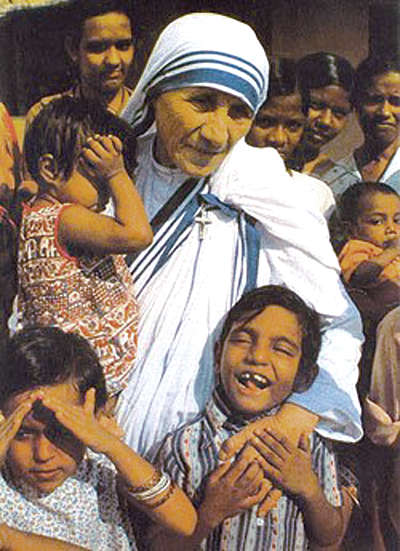 |
Mother Teresa’s motive in all her actions was the love of Christ and the will to “do something beautiful for God” in the service of the Church. “Being Catholic has total, absolute importance for me,” she said. “We are at the Church’s total disposal. We profess for the Holy Father a great, deep and personal love... We must affirm the truth of the Gospel by proclaiming the word of God without fear, openly, clearly, according to the Church’s teaching.” “The work we achieve is just a means for us to put in concrete form our love for Christ... We are given to the service of the poorest of the poor, that is to say, of Christ of whom the poor are the sorrowful image... Jesus in the Eucharist and Jesus in the poor, under the appearances of bread and under the appearances of the poor, that is what makes us contemplatives in the heart of the world.”
Adoration of the Blessed Sacrament holds an important place in the day of the Missionaries of Charity. They receive Holy Communion each day and the Sacrament of Penance each week. “Confession is a magnificent act, an act of great love. It is the moment in which I allow Christ to remove from me all that divides, all that destroys. For most of us there is a danger of forgetting that we are sinners and that we must make ourselves such in Confession.”
There is a very particular devotion to the Most Blessed Virgin among the disciples of Mother Teresa. “Mary is our guide, the cause of our joy. Pray to her. Say the Rosary so that the Virgin will always be with you, protect you, help you. Bring prayer into your families. The family that prays together, remains united.”
During the 1960’s, Mother Teresa’s work spread to almost all the dioceses of India. In 1965, sisters went to Venezuela. In March 1968, Paul VI asked Mother Teresa to open a house in Rome. After having visited the city’s suburbs and noted that material and moral misery exists even in “developed” countries, she accepted. At the same time, some sisters started work in Bangladesh, a country devastated by a horrible civil war. Many women had been raped by soldiers, and those who were pregnant were advised to have abortions. Mother Teresa declared to the government that she and her sisters would adopt the children, but that at no price should “these women who had suffered violence be made to commit a transgression which would accompany them for the rest of their lives.” Mother Teresa always fought with great energy and matchless courage against every form of abortion. She was convinced, rightly so, that from the moment of conception, the embryo is a man and possesses an inalienable right to life. No person, no authority, no reason whatsoever can dispose of the lives of innocent children.
In Yemen, a Muslim country into which no Christian influence had been able to penetrate for eight hundred years, Mother Teresa accepted to send a group of sisters on the condition that they could take a priest with them. In the 1980’s, the Order founded an average of fifteen new houses a year. Beginning in 1986, it settled in Communist countries which had heretofore been forbidden to all missionaries: Ethiopia, South Yemen, USSR, Albany, China.
In March 1967, to Mother Teresa’s work was added a masculine branch: the Congregation of Missionary Brothers. And in 1969, was born the Fraternity of Lay Co-workers of the Missionaries of Charity.
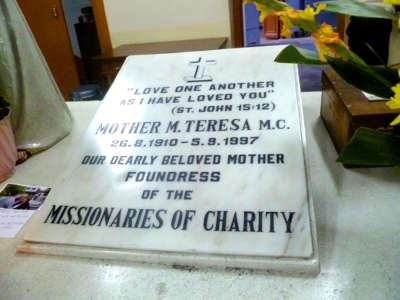 Epitaph on the tomb of Mother Teresa Epitaph on the tomb of Mother Teresa |
If asked whence came her moral strength, Mother Teresa would confide: “My secret is infinitely simple. I pray. Through prayer, I become one with Christ in love. To pray to Him, is to love Him.” Love is indissolubly united with joy. “Joy is prayer, in that it praises God: Man is created to praise. Joy is the hope of eternal happiness. Joy is a net of love to catch souls. True holiness consists in doing the will of God with a smile.”
After several hospitalizations, Mother Teresa passed away in the peace of the Lord, in Calcutta, on September 5, 1997. At the news of her death, Pope John Paul II summarized her life in this way: “Her mission began at dawn before the Eucharist. In the silence of contemplation, Mother Teresa heard the sound of Jesus’ cry on the Cross: I thirst. This cry, kept in the depth of her heart, pushed her out onto the streets of Calcutta and of all the suburbs of the world, searching for Jesus in the poor, the abandoned, the dying... Mother Teresa, unforgettable mother of the poor, is an eloquent model for all” (Angelus, September 7, 1997).
Many times, Mother Teresa answered young people who wanted to come help her in India, to remain in their countries in order to practice charity towards the “poor” of their own milieu. Here are some of her suggestions: “In France, just as in New York and everywhere, how much people hunger for love: that is a terrible form of poverty, without comparison with the poverty of Africans and Indians... It’s not so much how much you give, but the love with which you give that counts... Pray so that it begins in your own family. Children often have no one to greet them when they get home from school. When they are home with their parents, it’s just to sit in front of the television, and they do not exchange a word. That is deep poverty... You must work to make a living for your family, but have the courage to share with someone who does not have – maybe just a smile, a glass of water – to ask him to sit down and talk just a few minutes; maybe just write a letter to a sick person in the hospital... And even better, go to Nazareth and see how the Holy Family lives: Make of your family another Nazareth. Love Jesus! Often, during the day, say: ‘Jesus is in my heart. I believe in Your tender love for me, and I love You, Jesus.’ You must say it and repeat it constantly. And you will see the strength, the joy and the peace that will be yours, thanks to the love you have for Jesus. And you will be able to love others as Jesus loves you.”
It is possible to love others as Jesus does, for if we live in the grace of God, the Holy Spirit, who is Love, dwells in us (cf. Jn 14: 18). We ask Him to pour forth His Charity into your hearts, so that you may be His witnesses, following the example of Mother Teresa of Calcutta.
Dom Antoine Marie, OSB
This article is reprinted with permission from the Abbey of Clairval, France, which every month publishes a spiritual newsletter on the life of a saint in English, French, Italian, or Dutch. Their postal address: Dom Antoine Marie, Abbe, Abbaye Saint-Joseph de Clairval 21150 Flavigny sur Ozerain, France. Their website: www.clairval.com.